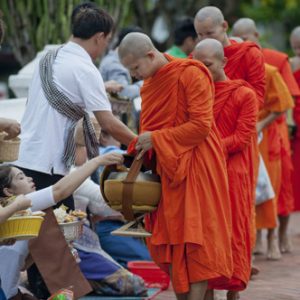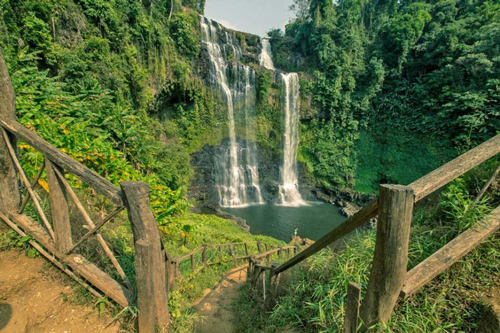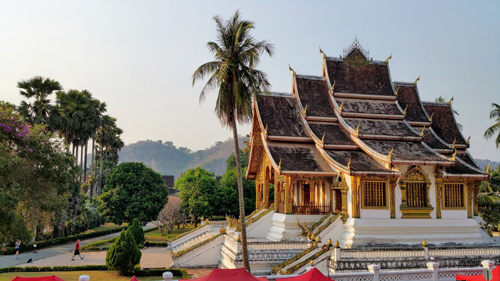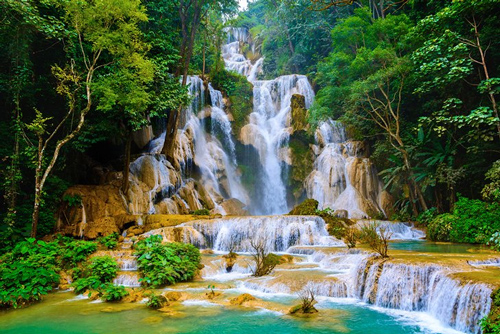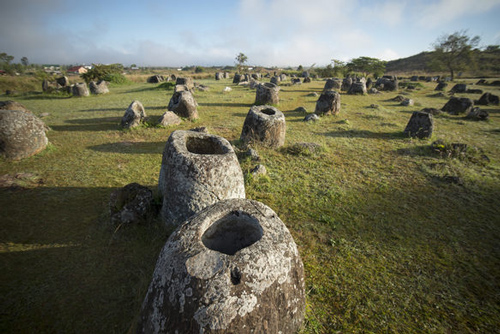Some tourists hesitate to travel to Laos during rainy season. However, all services will be cheaper during low season and you can have stunning photos without any other travelers around! Plus, the landscapes will be greener and more picturesque after a shower. This article will introduce some destinations and events you can include on your itinerary to Laos in rainy season.
Rainy Season in Laos

Bolaven Plateau – Pakse
May to October is the rainy season in Laos with an average temperature of 24 to 26 degrees Celsius. The early period of wet season (May to July) is hotter but the rains are short, while from late July to September, this country experiences several downpours, making transportation inconvenient. Moreover, Laos’ geography plays a major role in shaping its climate. The higher altitude areas are cooler but receive more rains. Further north and in Luang Prabang, the rainfall tends to be lighter and you can enjoy sightseeing activities.
Do not forget a raincoat or an umbrella when traveling to Laos during rainy season. If you are keen on trekking and hiking, leave your flip flops at home and switch to a high-quality pair of shoes or hiking boots. Do not forget to bring insect repellent to avoid the risk of fever caused by tropical mosquitoes.
Events and Festivals during Rainy Season in Laos
1. Boun Bang Fai/ Rocket Festival (May or June)
Boun Bang Fai or Rocket Festival is a Lao ritual to call for rain as well as a celebration of fertility. During this festival, rockets, which are made by stuffing gunpowder into decorated bamboo, are fired into the air. Each village will also put together a committee to judge and give out prizes for the best rockets. Also, the hosts will prepare a variety of traditional food for their guests and visitors.
2. Boun Khao Phansa (Mid July)

Boun Khao Phansa
Boun Khao Phansa is the start of three-month Buddhist Lent period which begins on the full moon of July and ends on the full moon of October. This festival is widely celebrated in Laos, Cambodia, and Thailand. On the festival, local villagers bring food offerings to the monks – this ritual is called ‘tak bat’. After this day, the monks will stay in their own temples to study the Buddha’s teachings as well as meditating.
3. Haw Khao Padap Din (Late August or early September)
This celebration is held to commemorate the dead. On this day, people will prepare a lot of Khao Tom (steamed sticky rice pack) to make offerings to monks, then put in the temples, four corners outside one’s house and house’s gate so that the spirits could reach them. The idea is to show respect not only to one’s own ancestors but also the dead with no relatives.
4. Boun Khao Salak (Mid September)

Boun Khao Salak
This is also a day to honor the deceased. It takes place 15 days after Haw Khao Padap Din. Lao people will prepare a basket filled with food and daily amenities such as soap, toothbrushes, and toilet paper along with the names of the dead person in the family. Families will give this basket to the monks so that the monks could transfer these items to the dead through prayers. Afterward, the items are shared among the monks and novices.
Recommended Places to Visit during Rainy Seasons in Laos
Do not let the rains prevent you from discovering this exotic country. Here are five most interesting places in Laos to travel in dry season:
1. Luang Prabang

Royal Palace – Luang Prabang, Laos
Compared to other parts of the country, Luang Prabang receives less rain and you can enjoy daytime sightseeing around the city. Visiting Luang Prabang, tourists will have the opportunity to explore the monasteries, monuments, traditional costumes, collections of old French house since the colonial era, and beautiful scenery. Luang Prabang is also where many traditional Lao wooden-structured houses remain. In 1996, Luang Prabang was voted as the World Heritage site.

Kuang Si Waterfalls – Luang Prabang, Laos
Don’t just stay around the city center; there are many things to explore outside the town. Kuang Si is one of the most spectacular waterfalls in Laos. However, since the roads will be quite muddy here during the rainy season, remember to bring a high-quality pair of shoes. If you find Kuang Si too challenging for you, you can choose to visit Pak Ou Caves. Nearby Luang Prabang, Pak Ou is a complex system of two caves, which are Lower Cave (Tham Ting) and Upper Cave (Tham Theung). The whole complex consists of more than 6000 ancient Buddha statues of different sizes and shapes. This cave is where nearby villagers and pilgrims from all over the world bring or send damaged and old Buddha statue for retirement instead of tossing them.
2. Vientiane

Wat Ho Phra Keo – Laos
You can visit this bustling capital city of Laos any time a year. You can see the fusion between a laid-back lifestyle and a vibrant wealth of luxurious hotels, restaurants, bars, and clubs in this colorful city. The city is dotted with solemn wats such as Wat Ho Phra Keo, Wat Si Muang, Wat Si Saket, and Wat Mai, French colonial boulevards, and exciting local markets. Coming to this city, you cannot miss That Luang Stupa, the symbol of Laos. The legend said that this stupa houses a breastbone of Buddha. 25 kilometers southeast of Vientiane, Buddha Park is an extraordinary sculpture park. Constructed by 1958 by Luang Pu (Venerable Grandfather) Bunleua Sulilat who studied both Buddhism and Hinduism, this park contains more than 200 Hindu and Buddhist statues.
3. Plain of Jars

Plain of Jars – Northeast Laos
Located in Xieng Khouang Province in the northeast of Laos, Plain of Jars is a mysterious ancient scene which is the Asian version of Stonehenge in the United Kingdom. Hundred of clay jars spread over the plain which can be dated to the ancient civilization over 2000 years ago. Scientists still cannot explain how people can place the jars onto the plain, nor the purposes they served. Plain of Jars is now considered an important archeological site in the country and it is a travelers’ favorite place on their tours to Laos.
4. Vang Vieng

Vang Vieng
Situated in the middle of Luang Prabang and Vientiane, Vang Vieng is probably a party town in the country with many tourists’ eateries, restaurants, bars, and clubs. There are many activities in this town such as rope swinging, zip lining, swimming, and diving; but pay attention to the weather forecast if you intend to participate in any of them. If the weather does not permit, it is fine to sightsee around the spectacular Nam Song River. Some attractions in Vang Vieng are Blue Lagoon, Water Cave (Tham Nam), Elephant Cave (Tham Chang) and Kaeng Nyui Waterfall.
5. Savannakhet

Dong Natad Forest – Savannakhet
Savannakhet means “Golden Land” due to its history as a trading post for the French colonialists, Vietnamese and Chinese merchants in 1920s. At present, the province focuses on mining natural resources like copper, gold, and producing tobacco products. Currently, it has a less interest in developing tourism resources and facilities. However, there are many attractions for tourists to visit such as the French colonial architectures, Wat Sayaphum, Tad Ing Hang Stupa, and Savanxay Market.
Related Reading:

